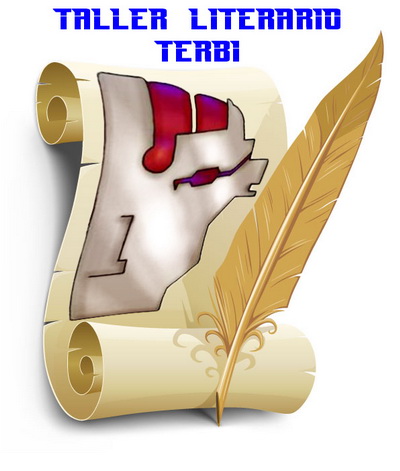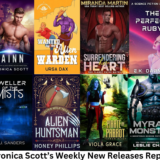Fanzines reviewed this episode: Coronal Mass Ejection (#4), Fadeaway (#44), Half-Life (#1), and The Acolyte (#14).
(Please note: Zine reviews are prepared a week or more in advance of publication of this column and may not necessarily include the latest issue available, but the link to multiple issues given at the bottom of each review probably does.)
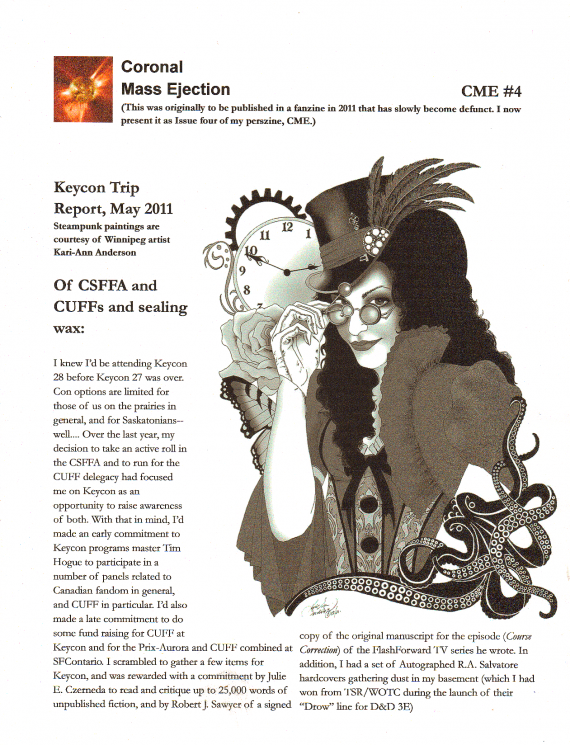
CORONAL MASS EJECTION (#4) – Find it here
Faned: Kent Pollard. Canadian Perzine.
This is even more “soonest” than is typical for a fanzine. As Kent explains: “This was originally to be published in a fanzine in 2011 that has slowly become defunct.”
Uhhm, yeah. In my proposed 21st issue of a zine which I published on behalf of the West Coast SF Association and the VCON convention, titled “WCSFAzine.” I intended to review VCON 36 but got bogged down describing the last gasp appearance of the “Sex Life of Godzilla” lecture featuring myself, Stan G. Hyde, and artist Guest of Honour Jean-Pierre Normand. I wanted to source a video recording of the lecture but couldn’t make out any of the words as they were overlaid by the noise of someone playing the spoons, or at least that’s what the audio track sounded like. Turns out it was the clattering of blades in a sword-fight demonstration held in the next room. Sigh. Never did finish that issue.
As an aside, I won the “Fan Achievement (Fanzine)” Aurora Award for WCSFAzine in 2010. It ceased publication the following year. This happens with award-winning zines surprisingly often. Something you faneds should consider when lusting for this or that award…
Anyway, apologies to Kent.
First thing to note, his layout looks better than mine. I’m notorious for bare bones, merely plugging art into column space where available. Kent took the trouble to treat the cover as a set piece, a visual whole, with Kari-Ann Anderson’s splendid steampunk art dominating the cover and catching the eye.
I also note that interior text is mostly single column, but in one instance art is placed in the centre of the page, splitting the text into double columns for the height of the art and then resuming single column. This adds variety to the visual appeal. Something I admit I would never do. Which is why you should study zines other than mine if you want to develop your layout skills.
CME #4 is in the tradition of a con report (here covering the May 2011 Keycon in Winnipeg), a very specialized form of con report, namely a fan fund winner’s trip report, in this case CUFF, the Canadian Unity Fan Fund, which promotes Canada-wide fen contact by sending an eastern fan to a western convention one year, and vice versa the next. The idea is that the CUFF winner shills like crazy for Canadian fandom, then writes up a report of his exciting adventures to inspire people to run in the following year’s CUFF election.
As CUFF winner, Kent took part in a panel with former CUFF winners Lyndie S. Bright and LeAmber Kensley to explain and explore the nature of CUFF: “Sadly, the only person to turn up just wanted to know what CUFF was, and after a very brief description, he felt he knew all he needed to and moved on… leaving the three of us with some quiet time for conversation amongst ourselves about CUFF and fandom…”
As a former CUFF winner I am familiar with the problem. Panels about CUFF generate no interest and are not worth doing. What DOES work is to meet and mingle with fans on a one-to-one basis and enthusiastically chat up the fund. Spread the word. Don’t lecture. Converse.
A special CUFF auction featuring material and services donated by pros like Robert J. Sawyer and Julie E. Czerneda raised $370.00 for CUFF, so kudos to Kent for organizing that.
To give you an idea how much fun Kent experienced, at one point he did something which an old fuddy like me would never think of doing. He ran out to a dollar store and a second-hand clothes store to put together a steampunk costume consisting of: army boots, ratty knee-length leather coat, top hat, goggles, red broom handle, copper pot handle, and a slinky. Can’t quite picture it, and I see no mention of receiving a costume award, but I bet it was rather striking.
As a 25 year veteran book seller, he took part in many panels on subjects other than CUFF, including one about “Grants for Writers.” Of particular interest, he quotes Chadwick Ginther as saying: “…grant juries tend to see ‘research trip’ as equivalent to ‘paid vacation’ and suggested substituting ‘location scouting.” Wise words.
Coronal Mass Ejection worth reading? – Yes. Because it promotes CUFF. But also because it is a good example of a con report fulfilling its role, i.e. revealing everything neat and nifty about a convention and the people involved. While this is of value to participants as a memory-lane souvenir, more importantly it conveys the flavour of the con to people who did not attend, and thus adds to fandom-wide enthusiasm for conventions in general. This is why con reports are valuable and worth doing.
If you are contemplating launching your own zine, writing a con report is a good beginning, a first-hand experience article jumpstarting your creative juices, secure in the knowledge that many fen, being inveterate congoers, are ALWAYS interested in reading con reports. Besides, fits with the standard advice of “write about what you know.”
No Lloyd Penney loc because no letter of comment column. This is understandable, the issue being in the nature of a sudden impulse to publish that which was never published by a certain twit of a faned…
( Multiple issues of Coronal Mass Ejection here )
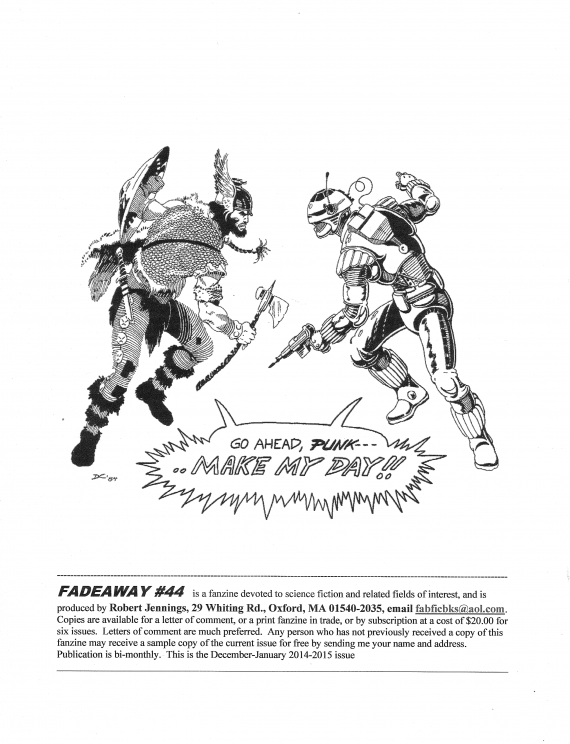
FADEAWAY (#44) – December 2014 – Find it here
Faned: Robert Jennings. American Perzine.
Self-described as a fanzine “devoted to science fiction and related fields of interest.” Since I review SF&F fanzines you possibly take this as a matter of course. Actually, it’s not. Some SF&F fanzines contain very little SF&F. In fact, some contain none at all, a feature over which the faned exhibits considerable pride. Confusing? Don’t worry about it. You’ll get the hang of it eventually. A few hundred zines read and you’ll understand perfectly.
Faned Robert Jennings, a book seller for many years, takes genre fiction seriously, very seriously, to the point of writing exquisitely detailed essays on authors and book series. The highlight of this issue is a 14 page article about “Bomba, the Jungle Boy.”
Never heard of Bomba? Never heard of the twenty books in print from the 1930s through to the 1970s? Never seen any of the twelve films released between 1949 and 1955? Never read any of the seven issues of the comic book? Some would consider you lucky.
Take Jennings description of “Bomba the Jungle Boy; or, The Old Naturalist’s Secret,” the first volume of the series: “We read along as Bomba is attacked by a swarm of vicious alligators, which he manages to elude by skill, cunning, and raw strength. But just as he is about to disengage himself, he manages to fall prey to a marauding anaconda snake which decides to squeeze him to jelly right on the spot. Luckily Bomba manages to kill the coiled menace by skill, cunning, and raw strength, but after escaping this hideous death, he is suddenly faced with that relentless terror of the jungle, a ferocious jaguar looking for a light mid-day brunch about Bomba’s size. Bomba of course manages to escape by the quick use of his skill, cunning, and raw strength, only to fall prey to the raging forces of nature as a tropical storm and a flash flood threaten to end his life midway thru the very first volume. Luckily however, Bomba can rely on skill, cunning and raw strength in this time of crisis, so he manages to escape alive, only to fall into the next chapter with yet another disaster roaring down on him.”
As Jennings points out, not for nothing did juvenile readers turn to Burrough’s “Tarzan” series and find it rather slow. On the other hand, Jennings nails it, “skill, cunning and raw strength” being about the limit of Bomba’s talents. I read a few of the series as a little kid in the late fifties, but when I took up the Ballantine reprints of the Tarzan series in the sixties I found the latter refreshingly innovative, imaginative and well written in comparison. I have since found out there are a few writers who actually wrote better than Burroughs… James Joyce, for instance… though I don’t believe he ever tackled genre fiction. Pity. Also pitiful, nobody knows who wrote the Bomba series. Probably more than one ghost writer, all published under the house name “Roy Rockwood.”
The letter of comment column features 13 contributors (including Lloyd Penney), most of whom have a lot to say about the contents of the previous issue. This goes to show that SOME readers of SF&F fanzines ARE interested in SF&F topics.
Fadeaway worth reading? – For me, personally, yes, the Bomba article being an exercise in nostalgia. For anyone interested in fantasy literature, the same essay, describing the most successful imitator of “Tarzan,” makes it worthwhile. And if you are fascinated by the literary history of the genre, as I am, FADEAWAY is a must read, for it always highlights one or more topics of extreme interest.
( Multiple issues of Fadeaway here )

HALF-LIFE (#1) – December 2014 – Find it here
Faned: Ryan Speer. American Perzine.
Welcome! Welcome! Welcome! And I say again, from the heart, welcome!
Simply put, the first issue of a brand-new fanzine from a newly-minted faned!
Important to stress zinedom’s delight at the appearance of HALF-LIFE because Ryan might be pulled off stride by comments about alleged faults and mistakes typical of a newcomer.
For instance, starting off with a page of Calibri text set at point size twenty. Unusual choice. However, it does emphasise the few paragraphs listing his credentials. He’s experimented with Apas apparently, and figures a perzine might be more suitable to his taste. He writes: “I have hovered at the periphery of Fandom for a few years now… I like: Frank Paul, Conan, Edd Cartier, Phil Farmer, Budrys book reviews, Solaris, ST:NG, Ken MacLeod.”
Is this the making of a science fiction fan and faned? Absolutely! Off to a good start. All he has to do is write about these interests with enthusiasm. No doubt his interests will expand as time goes on, giving him even more topics to excitedly share with his fellow fen. But how well does he express himself in this first issue? How successful a zine is it?
I figure an article (first in a series?) titled “Our Favorite Nuclear Blasts” starts things off with a bang. Given he’s describing the underground explosion of a 380 ton nuclear device near Hattiesburg, Mississippi in October of 1964, I have some doubts concerning the veracity of this article. Nicely backed up with a photo and diagram though. Appropriate to the nifty cover too.
Another article, this one labelled “imaginary,” Talks about William L. Crawford’s MARVEL TALES from the 1930s and includes a reproduction of the cover of the second issue. He cites P. 782 from the Clute/Nicholls SF Encyclopedia as a source. I looked it up. Sure enough, genuine zine. So what’s the “imaginary” aspect? Written for the Virginia tech library blog as if it were real. But it is real.
This faned is playing with his readers’ minds! I like that.
He mentions that his current projects include reading all of Heinlein’s juveniles and exploring the Tarzan series in order to “understand Farmer’s pastiches,” all of which may result in some reviews in the next issue.
I note the lack of a letter of comment from Lloyd Penney. Not surprising, given that this is the first issue.
Half-Life worth reading? – Yes! In a few short pages Ryan defines some of his interests and exhibits his sense of humour. Both very promising. You should read this and send him a positive letter of comment. New fanzines rarer than hen’s teeth. Greatly to be encouraged! I look forward to the next issue.
AND FROM THE VAULTS:
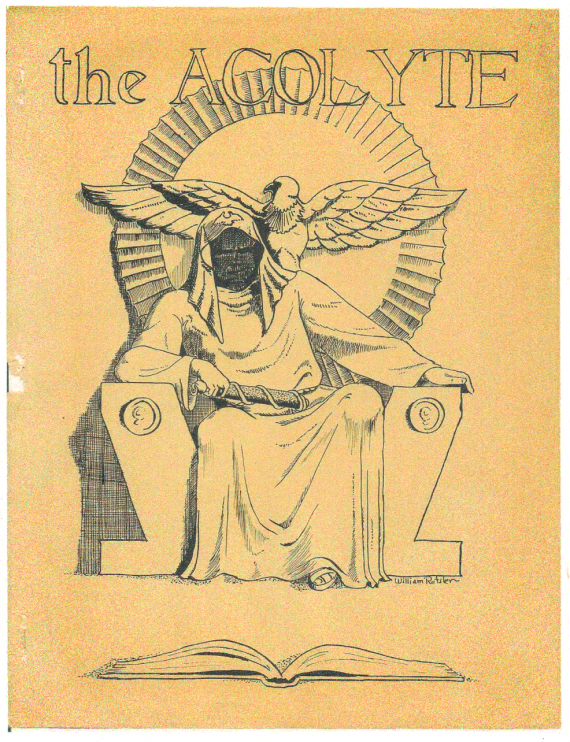
THE ACOLYTE (#14) – Find it here
Faned: Francis T. Laney. American Genzine.
This zine was started by Laney in 1942 and carried on till this final issue in 1946, picking up a co-editor or two along the way. It is an example of what constituted a quality zine in the forties.
Many “quality” contributors as well. As a Canadian fanhistorian my jaw dropped when I saw it contained articles by two well-known Canadian fen of the era.
First, John Hollis Mason, a Montreal fan, who contributes an article on the novel “A New Adam” in which a Slan-like superman (not THE Superman) struggles, not to conquer the world, but to find happiness. Article contains this interesting comment: “I suggest the substitution of the word ‘mutant’ for ‘superman.’ At least it conveys better the idea of change, and hasn’t as many wrong associations – yet – as the other.” So soon after the war, extolling the virtues of supermen, perfect humans, is viewed as uncomfortably close to the “master race” concept.
Second, William R. Gibson (NOT the contemporary author William Gibson), one of the greatest genre book collectors ever, contributes reviews of books from his collection, books with titles like “The Incubated Girl,” “New Bodies for Old,” and “The Avenging Ray.” Bill was also a prominent fan artist, with art appearing in numerous zines (Canadian, American and British) from the 1940s through the 1970s. The back cover art, depicting two flying creatures, is an example of his work.
I should add that the front cover is an early work by William Rotsler, one of the most popular and sought after fan artists of all time. The annual Rotsler Awards, for fan art, are named in his honour.
There are also some terrific articles on films and books, but my favourite is a set of short film reviews by the number one fan in the world (so voted at the time), Forrest J Ackerman. He couldn’t be bothered to see “White Pongo” (a white gorilla on a rampage) and reviewed it on the basis of the still photos displayed on the outside of the theatre! Cheeky lad.
No loc by Lloyd Penney. He wasn’t born yet.
The Acolyte worth reading? – Absolutely! An example of what the good stuff was like in the good old days.
BY THE WAY:
If starting up your own zine seems intimidating, consider utilizing Lloyd Penney as a role model and send off a bunch of locs. This will open up a whole world of contacts and conversation which could well give you the confidence to launch your own zine.
You can find a fantastic collection of zines at: Efanzines
You can find a quite good selection of Canadian zines at: Canadian SF Fanzine Archive



